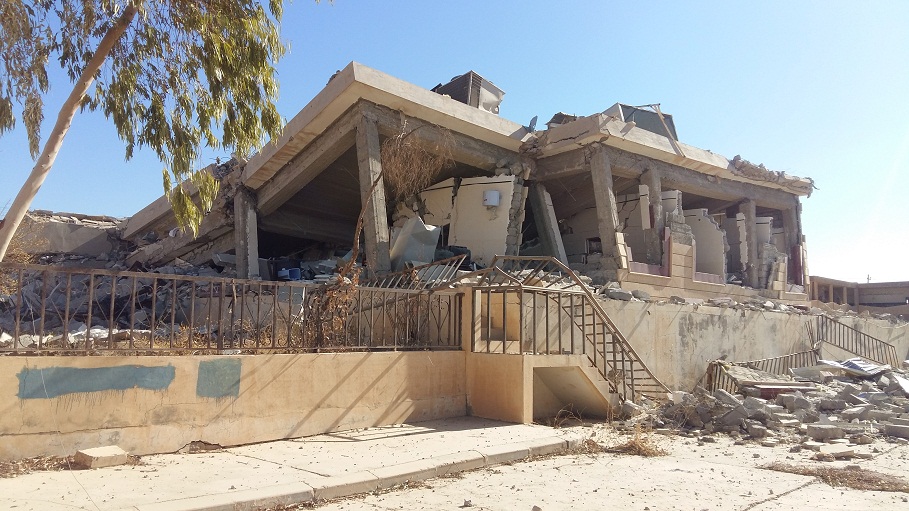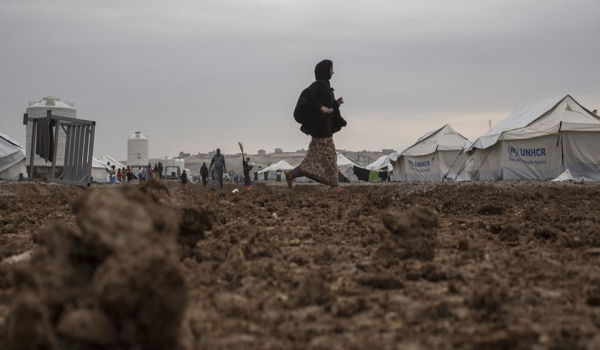“It has been three years since we have called upon the government and the relevant international organizations to dig up the bodies that the Islamic State group (IS) have buried in Allo Antar hole,” Hussein Raza with his eyes full of tears expressed his feeling. He is concerned as the third anniversary of the liberation of Tal Afar reaches.
Even though Tal Afar has been liberated from IS for three years, still, the families of the victims wait for the government and relevant institutions to dig up the corpses, whose identities are unknown.
Raza asks for the excavation of the hole so that the corpses can be given back to their families to bury them respectfully after conducting DNA tests for the recognition of their identities. “they do not even have the death certificates.”

Nineveh, clothes of corpses are visible, March 2020. Photo Jaafar Tal Afari
After taking over Nineveh province in mid 2014, including Tal Afar sub-district, IS militants used the Allo Antar hole to bury those whom they saw as their opponents.
The Families of the Victims are Living Evidence
Raza said , “after controlling the areas, IS brought the dead bodies to Allo Antar hole and buried them there.”
He also mentioned that “anyone who opposed the ideology of the group would have been thrown into that hole. For instance, bodies of the Ezidis and the Shia Turkmen IS killed were dumped into the hole.”
“Daesh blindfolded and tied the hands of the victims. They threw them alive into the hole and buried them,” Raza explained the way Daesh killed the people.
Ali Ahmad, who lives in Tal Afar, tells the story of his father and his uncle who were killed and their corpses are still missing. His relatives stated they were killed and thrown into that hole.
He said, “my dad and uncle fled Tal Afar after the arrival of Daesh. They headed to Sinjar, which was under control of Daesh. After a few days, we were informed that Daesh killed both of them and threw them into that hole. We were still in contact with some relatives and friends in Tal Afar. They told us about the crimes IS were committing, including dumping dead bodies into the Allo Antar hole.”
While Ahmad was talking, he was pointing his fingers at the hole and stated, “I guess that the corpses of my dad and uncle are in that hole. As you see from the corpses, some of them were shot, and some were beheaded.”
At the same time, Fatima Sa’d, who is the wife of one of the victims killed by Daesh, demonstrates the disappearance story of her husband. “When we were having dinner, five militants with long beard raided our house and arrested my husband… we did not receive any news about him. Later we heard that Deash executed them and threw their bodies into that hole,” she said.
The Iraqi Security Forces in August 2017 liberated Tal Afar Subdistrict, whose population is predominately Turkmen and is around 220 thousand.
The Corpses of a Thousand Ezidis and Turkmen
Ali Bayati, a member of the Iraqi High Commission for Human Rights (IHCHR), believes that “the Allo Antar hole has collected many shreds of evidence in itself, the graveyard is a piece of evidence about the scale of the crimes the terrorist groups, Al Qaeda or IS, committed. Also, it is also evidence showing that Turkmen were targeted by Daesh as IS targeted the other components.”
Bayati told KirkukNow, “our evidence is ready for the relevant authorities. The government and the international organizations should start their duties to investigate and record these crimes. Later, holding people accountable and putiing them on trial to become a tool to take the rights of the victims, through digging up the dead bodies and recognizing them as well as compensating their families. Also, creating opportunities for the families to hold a respectful burial.”
Bayati explained that they, as IHCHR, have worked on many aspects of the case and have asked to prioritize the excavation of the corpses. Also, they have discussed the matter with the international committee formed by the United Nations’ security council to investigate the .crimes committed by Daesh
The IHCHR held talks with the international committee to accelerate the determination of the cases of those victims when the committee visited Tal Afar in February 2020.
“We are attempting to investigate the crime, put the perpetrators on trial, and compensate the families of the victims,” Bayati said.
Even though the precise number will be known after the excavation, numerous unknown reasons are barriers for the excavation, Bayaati claimed.
Approximately a thousand and 300 Turkmen disappeared during the time when IS controlled Nineveh province, mostly lived and disappeared in Tal Afar and Sinjar in 2014. The rest went missing from 2014 until 2017.
Local Administration: Excavating the Corpses is not Under our Authorities
A source from the security forces in Tal Afar told KirkukNow, “the responsibility of the security institutions is restricted to remove mines and the aftermath of the war. Digging up the bodies is not in our authority because it needs a specialized committee that does the work under the supervision of the international organization.”
The source also mentioned, “there is a checkpoint near the graveyard (the hole) so that it is preserved until the relevant authorities take actions.”
Qassem Mohammed Sharif, Tal Afar commissioner, stated, “the graveyard is located somewhere around Tal Afar. This graveyard contains a significant number of civilian corpses, who were killed by IS.”
He also explained that “the excavation of the graves requires a central committee, which is outside of the authorities of local administration.

Nineveh, a building that was damaged in the liberation of Tal Afar, 2017. Photo: Jaafar Tal Afari
The commissioner stated that there is no exact number of the people dumbed into the hole.
Corpses of women and children
Allo Antar hole is located on the outskirts of Tal Afar and is six km away from the center of the sub-district. The hole is 600 meters away from the main streets and is in a desert. It is near to Bagi Qut village, whose inhabitants are Shia Turkmen.
Ibtisam Haio, a Turkmen activist, said, “the hole is known as the hole of the doves as dove swarms have been seen there, but the Turkmen call it Allo Antar. The hole is natural and is not human-made. Some people in Tal Afar say hundreds of years ago an asteroid hit the areas and created the hole.”
He also stated, “the diameter of the hole is estimated at 50 meters, and its depth is 100 meters, but due to filling up, its depth has decreased… it is clear that IS used this site as a ground for execution and dumping bodied of the victims into it.
Haio,who is head of the Cultural Dialogue for Relief and Development Organization, stated that “among the tens of bodies that have decayed and have become visible, women and children corpses are seen. The cloths of the some of the corpses indicate they are Ezidis. Also, the dried blood and bullets are evidence for the crimes.”
“Based on our information, the corpses are mostly Ezidis and Turkmen, including the corpse of Iman Mohammed Yunis, who was an activist and a former parliament member. She was killed by IS, and her body was dumped into the hole.”
Islamic State killed thousands of Iraqi people and buried their corpses in mass. Daesh killed Ezidis and Turkmen in mass when they controlled Nineveh province in 2014.
Hussein Raza, after three years of liberation of Tal Afar, still waits for excavation of the corpses of his families.





